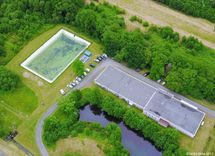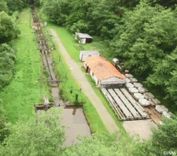Facilities
Transnational Access
Metadata & Data
Papers & Reports
Knowledge Base
LIFE Infrastructure - ECP Facility
Institut National de la Recherche Agronomique
Infrastructure Description
LIFE-ECP is part of INRA, a multi-site infrastructure offering micro- meso- and macrocosms for the implementation of scientific programs focused on aquatic ecology. ECP facilities offer the opportunity to work with various sizes of artificial flowing-water mesocosms. They are located at two sites: at the INRA Aquapôle Campus and at Lapitxuri (15 km apart). The Aquapôle platform consists of an outdoor platform (60m2) for fish rearing equipped with 4 tanks (2.5 m3) and a series of circular tanks in multiple sizes (0.16m3, 0.5m3, 0.1m3). The indoor facilities consist of 4 experimental rooms, all equipped with independent temperature and light control, holding a series of circular flumes in various sizes (4-25 m3). Water (diverted from the nearby river Nivelle) velocity, substratum and depth can be controlled as well as flow direction to mimic tide. Indoor flumes can be connected to micro- respirometry devices, offering a total of 54 metabolic chambers of different sizes (4 cm3 to 4000 cm3).
The Lapitxuri semi-natural stream is fed by a diversion of two natural headwater streams. It consists into 12 consecutive reaches (10 x 2.8m) that are separated from each other by 2 downstream traps. Underwater rooms allow direct
observations through glass windows in two of these reaches. Under its basic arrangement the Lapitxuri semi-natural stream looks like a succession of riffle units with coarse and medium gravel substratum, 10-15 cm of water height and 12-17 cm s-1 water velocity. These parameters can be manipulated to create different habitats through changes in substratum quality and height, shelter additions, change in water height and/or flow input. At mid-distance, a flow diversion makes it possible to work with different flow values between the upstream and downstream part of the stream. The entire stream is protected from avian predation by nets and from unwanted fish entry by traps. The addition of a longitudinal division increases the number of pseudo-replicates to 24 reaches of 14 m2 each.
Tanks of different sizes fed in open-water allow to maintain fish under optimal conditions before and after experiments. A laboratory allows sampling, biometric or video-recording works. A wet room is dedicated to eggs, larvae or invertebrates rearing.

Facility Description
St Pée facilities offer the opportunity to work with various sizes of artificial flowing-water mesocosms.
The Lapitxuri semi-natural stream (15 km from the INRA St Pée Institute) is fed by a diversion of a natural headwater stream. It is separated into 13 consecutive reaches (10m x 2.8m) allowing it to work with pseudo-replicates (each reach can be closed by downstream traps). T). Direct underwater observations can be performed on two reaches from an underground room. More classical mesocosms are available: 16 swedish tanks (2.5 m3), 8 circular tanks (0.1 m3), 6 indoor flumes (4.5 m long), 8 outdoor flumes (11m x 0.5m).
At the INRA St Pée Institute, a large 25 m3 circular flume (fluvarium) consists in 2 longitudinal sections (10 m x 1 m) separated by upstream and downstream traps. Water velocity (controlled by a propeller), light (twilight period possible), temperature (air+water), substratum and depth can be controlled.
Two smaller circular devices (tidal aquaria) consist of a 400 L aquarium where flow direction changes alternatively. They are located in two similar rooms, where air and water temperature, as well as light are controlled. It is used to investigate swimming behavior in tidal zone under different conditions or as replicates.
An outdoor large basin (756 m²) can be used under lentic (maximum depth: 4 m) or lotic (maximum depth: 80 cm) experimental situations. More classical mesocosms are available: 4 swedish tanks (2.5 m3), 2 series of 8 circular tanks (0. 16 or 0.5 m3), 1 series of 16 tanks (0.1 m3), 6 indoor flumes (1.50 m long).
Organisation Address
INRAE – Aquapôle, Ibarron
St-Pée-sur-Nivelle
64310
France
Infrastructure Address
Aquapôle
St Pée-sur-Nivelle
Basque-Country
France
Information Sources
https://www6.bordeaux-aquitaine.inra.fr/ie-ecp-ecobiop
Research website: https://ecobiop.com/Location
Gallery
Contacts
Jean-Christophe Aymes
Controlled Parameters
- Discharge
- water velocity
- temperature
- light
- photoperiod
- physical habitat and stream morphology
- species compsition and individual characteristics
Research Topics
Evolution in Biodiversity under global change
Fish behavioral and physiological response to anthropogenic pressure (in particular for flow in context of climate change)
Experiment Years
1982 - present (large flume, semi-natural stream); 2009 - present (tidal aquaria,, outdoor large basin)
TA Support
Services currently offered by the infrastructure: ECP runs relatively short-term experiments on the interactive effects of local and/or global changes on freshwater organisms (mainly fishes). Both sites (Aquapôle & Lapitxuri) function under running water conditions. All users will be offered technical, scientific and logistic support before and during the experiments as well as offices and lab space.
Various capture and trapping systems, video-recording (including IR and UV lighting) as well as RFID technology. At Aquapôle, a laboratory offers microscopes (with capture image system), scales, freezers -20° and -80°, a stove, an extractor hood, nitrogen containers. At the Lapitxuri site, the lab is equipped with a bench and a freezer. A microscope equipped with the capture image system can be transferred there.
Support offered under AQUACOSM-plus: Users will have access to the different facilities as well as to equipment and laboratories available at ECP (see above). Through collaboration with on-site researchers (https://ecobiop.com/), TA users will also benefit from additional skills and expertise of a broad scientific community. Accommodation is available in the vicinity of Aquapôle. At the Lapitxuri site, a container house equipped with two beds, a small kitchen and a toilet can be used when experiments necessitate 24 h sampling work.
TA Modality of Access
Modality of access under AQUACOSM-plus: At least 110 person-days in total will be allocated to external users supported by an AQUACOSM-plus TA activity. It is anticipated that AQUACOSM-plus will support stays of at least 4 persons for 28 days per year in M22-33.
TA Accommodation
St Pée Inra Institute: Several hotels or guest houses are available in St Pée-sur-Nivelle town (located at 30 min from Biarritz Airport/Train station).
Lapitxuri: (20 min from St Pée) A container house equipped with two beds, a small kitchen and a toilet at the experimental site.



